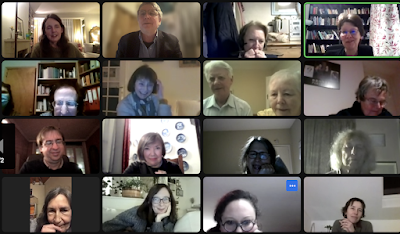We should pay more attention to the somewhat minor characters in literature. That's the message from Robynn Colwell in an engaging presentation on secondary characters in nineteenth century literature, the latest of member talk for the Brussels Brontë Group. In her talk on 9 February, Robynn focused on the interesting and important roles of key secondary characters in several 19th-century novels:
A Room With a View by E.M.
Forster
The Portrait of a Lady
by Henry James
Anna Karenina by Leo
Tolstoy
Jane Eyre by Charlotte
Brontë
In A Room With a View, Robynn focused on Charlotte
Bartlett and the role Charlotte seems to play in bringing together Lucy
Honeychurch and George Emerson. Charlotte “keeps bringing George to mind,”
Robynn said. “Charlotte Bartlett is more than a character; she is a deliberate
and cleverly embedded device, a kind of guide for the reader,” Robynn told us.
In The Portrait of a Lady by, Robynn focused on
Ralph Touchett, whom she called a “brilliantly crafted literary device.” She said
Ralph is “kind of like a double agent, living among the fictional characters
but sending the reader encoded messages apprising us of the truth while
everything else in the novel remains acutely loyal to Isabel’s naïve quest for
self-discovery.”
 |
| Robynn Colwell |
In Anna Karenina by Robynn surprised many of us by focusing on Laska, Levin’s hunting dog. Tolstoy lets us into the consciousness of Laska and shows us the contrasting “instincts and motivations” of Laska and Levin, echoing the similar contrasts in society. “Laska’s moment in the spotlight, or moonlight as it happens, gives us a simplified version of these more complex dynamics” in human relations.
Robynn concluded with Jane Eyre, focusing on
Bertha Mason and St. John Rivers, and the contrasts (and links) that those
characters have to the main characters in Charlotte Brontë’s story. She used
those characters as a launchpad for an insightful discussion of “desire and
dignity” in the novel.
Her talk was followed by a lively discussion as the
audience on Zoom delved into much more than just the secondary characters,
particularly regarding Jane Eyre.

No comments:
Post a Comment